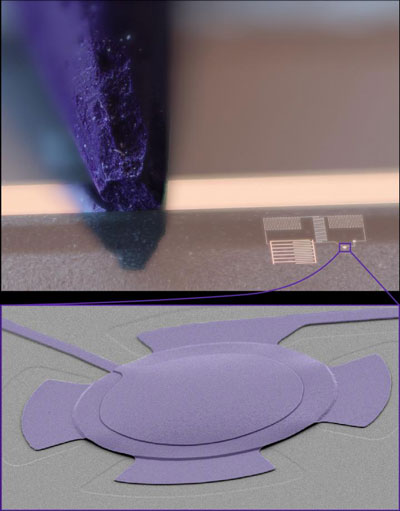| Posted: May 15, 2017 |
Quantum reservoir for microwaves
(Nanowerk News) In a recent experiment at EPFL, a microwave resonator, a circuit that supports electric signals oscillating at a resonance frequency, is coupled to the vibrations of a metallic micro-drum. By actively cooling the mechanical motion close to the lowest energy allowed by quantum mechanics, the micro-drum can be turned into a quantum reservoir - an environment that can shape the states of the microwaves.
|
|
The findings are published as an advanced publication in Nature Physics ("A dissipative quantum reservoir for microwave light using a mechanical oscillator").
|
 |
| Photograph of the chip used in the experiment to couple a microwave cavity to a micrometer-size drum (the sharp purple pencil tip is placed as a scale). Inset shows a scanning electron micrograph of the drum. The top membrane of the drum is suspended only 50nm (1/2000th of the diameter of hair) above a metal plate. This is then used to manipulate and amplify microwaves in the quantum regime. (Image: N. R. Bernier and L. D. Tóth, EPFL)
|
|
László Dániel Tóth, Nathan Bernier, and Dr Alexey Feofanov led the research effort in Tobias Kippenberg's Laboratory of Photonics and Quantum Measurements at EPFL, with support from Dr Andreas Nunnenkamp, a theorist at the University of Cambridge, UK.
|
|
Microwaves are electromagnetic waves, just like visible light, but with a frequency that is four orders of magnitude smaller. Microwaves form the backbone of several everyday technologies, from microwave ovens and cellular phones to satellite communication, and have recently gained further importance in manipulating quantum information in superconducting circuits -- one of the most promising candidates to realize future quantum computers.
|
|
The micro-drum, only 30 microns in diameter, 100 nanometers thick and fabricated in the Center of MicroNanotechnology (CMi) at EPFL, constitutes the top plate of a capacitor in a superconducting microwave resonator. The drum's position modulates the resonator's resonance frequency and, conversely, a voltage across the capacitor exerts a force on the micro-drum. Through this bidirectional interaction, energy can be exchanged between mechanical vibrations and the microwave oscillations in the superconducting circuit.
|
|
In the experiment, the micro-drum is first cooled close to its lowest energy quantum level by a suitably tuned microwave tone. Every microwave photon (a quantum of light) carries away the energy of a phonon (a quantum of mechanical motion) such that the mechanical energy is reduced. This cooling process increases the dissipation and turns the micro-drum into a dissipative reservoir for the microwave resonator.
|
|
By tuning the interactions between the cavity and the cooled micro-drum, which is now an environment for the microwaves, the cavity can be turned into a microwave amplifier. The most interesting aspect of this amplification process is the added noise, that is, how much random, unwanted fluctuations are added to the amplified signal.
|
|
Albeit counter-intuitive, quantum mechanics dictates that this added noise cannot be suppressed completely, even in principle. The amplifier realized in the EPFL experiment operates very close to this limit, therefore it is as "quiet" as it can be. Interestingly, in a different regime, the micro-drum turns the microwave resonator into a maser (or microwave laser).
|
|
"There has been a lot of research focus on bringing mechanical oscillators into the quantum regime in the past few years." says Dr. Alexey Feofanov, postdoctoral researcher on the project. "However, our experiment is one of the first which actually shows and harnesses their capabilities for future quantum technologies."
|
|
Looking ahead, this experiment enables novel phenomena in cavity optomechanical systems like noiseless microwave routing or microwave entanglement. Generally, it proves that mechanical oscillators can be a useful resource in the rapidly growing field of quantum science and engineering.
|
|
Future activities on the emerging research possibilities created by this work will be supported by two recently started EC Horizon 2020 projects: Hybrid Optomechanical Technologies (HOT) and Optomechanical Technologies (OMT), both coordinated at EPFL.
|

